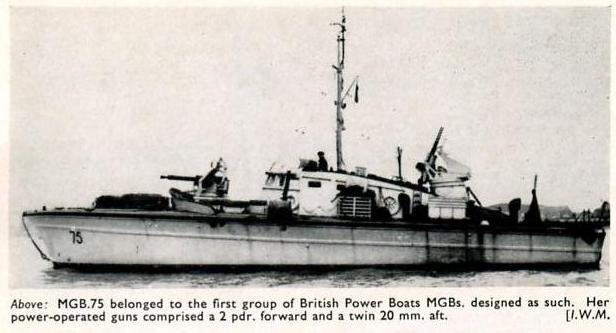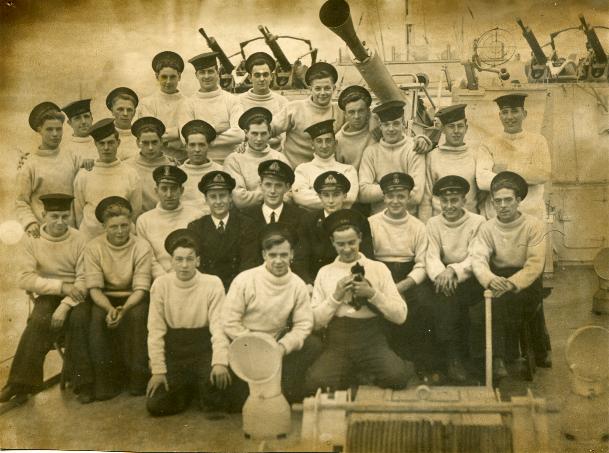 I
thought it was time for me to make a special effort to overcome my later
years of wear and tear and remember a few experiences about “What did
you do in the war, Daddy?” A question now remote, as my eldest son is
now 6l. However, here are a few experiences I remember well. Some
perhaps funny, some more poignant, but nevertheless indelibly printed in
my memory.
I
thought it was time for me to make a special effort to overcome my later
years of wear and tear and remember a few experiences about “What did
you do in the war, Daddy?” A question now remote, as my eldest son is
now 6l. However, here are a few experiences I remember well. Some
perhaps funny, some more poignant, but nevertheless indelibly printed in
my memory.
Early days! I
left HMS Raleigh, Torpoint, in September l940 after nine weeks intensive
training, able to tie knots, fire a rifle and man a 4” gun which I never
did again, and left, a raw OS DJX 202862.
My first posting
was to Fowey, Cornwall, to join MGB 650, a Scott Payne 70 footer tied up
alongside the depot ship HMS Belfort, moored just above Bodinnick. The
Bridge was surmounted by a plaque inscribed with the skipper’s motto “By
Guess or by God”. I thought a few prayers may be in order before I
boarded, if that was to be taken literally.
A Scotsman (name
escapes me) took me in hand and promptly made me chef (I who had never
even boiled an egg). That I suppose was “guess” number 1. He also
introduced me to my action station and presented me with a stripped
Lewis and taught me in five minutes how to use it and keep it clean. No
2 guess. My bunk was so close to the deck head, I had to squeeze in and
out my locker just above the bilges, which were also my responsibility,
in between handling the grub, cooking being done on a primus stove,
ignited by meths...
Going out on
trials one day, we fell foul of a German acoustic mine and overturned.
No lives were lost but the boat was towed back and placed on the slips
at Polruan for a re-fit. I and some of the crew and skipper were sent
to Milford Haven to pick up a yacht “The Sister Anne” back from the
Med. Our assignment was to take this back to Fowey to serve as an
Officers’ depot ship. All very posh to look at but used to "Harry
Flatters”, not to Lands End weather conditions. Having rounded
Eddystone, we made 2 knots in a force 8 up the channel, rolling and
pitching in a horrendous manner and my first introduction to
sea-sickness ensued. A Sunderland aircraft was sent out to look for us
as we were long overdue in Fowey but we travelled East until on reaching
Fowey we were informed to carry on to Plymouth as the harbour had been
mined. We returned to Fowey two days later when the harbour mouth had
been swept.
After a few weeks
of comparative luxury, I was considered wasted on the yacht and drafted
back to Portland for subsequent draft to MGB 88 in Glasgow, a boat made
at considerable expense in USA, though of Scott Payne design. After
being temporarily billeted in a Govan doss house, we commissioned, and
accompanied by MGB 692 set sail for Portland. Now, the North Channel
can blow up in minutes and we had a force 6 in no time. We pitched our
way South with a new boat and 5,000 rounds of .5 ammo in the “C” space
which eventually smashed the thwarts and came to rest on the tanks,
giving no small cause for alarm. Then we hit some wreckage and stove in
part of the bow and had to close the water-tight door to the heads to
keep the forward mess deck from flooding.
With Milford
Haven to port, the skipper decided to seek refuge and we put in there,
being unseaworthy, for temporary repairs, until we could later get round
to Poole for repairs at British Powerboats. The ratings then went to
No. 10 High Street, (still there and now a protected building) where we
stayed for about a week, living in digs and on a diet of sheep’s head
before being drafted to Liverpool to pick up another Scott Payne, MGB
89. With this boat we became attached to the 3rd Flotilla,
based in Lowestoft, doing “Z” patrols and one or two offensive patrols
to the other side.
On one occasion
we encountered E Boats and in the ensuing skirmish my Gunner (to whom I
was loading number) lost an arm and I was lucky to escape as my shield
was penetrated by an armour-piercing bullet which left a hole like a
“two bob piece”. I reloaded and then unclipped his gun harness, and
laid him safely on the deck. Nick Carter was his name, from Ireland,
and when I saw him later in Lowestoft Hospital he was cheerful and
optimistic about his possible future as a lift attendant in some
departmental store. He was very much a fatalist and seemed happy to
accept his lot.
There was
sufficient other damage to warrant a return to the “slips” for repairs
so a further draft was arranged for me to MGB 75, a 71’6” craft built
at British Powerboats, Poole, and seconded to the 7th
Flotilla at Felixstowe, prior to commissioning at Southampton, after a
week with crew members at Dibden Lodge, Hythe. The skipper was Lt.
Ladner, a Canadian who achieved quite a measure of fame in Coastal
Forces.

In Summer we
operated from Dartmouth around the Channel Islands, Alderney in
particular which the Germans had in firm control. I was loading number
on the twin Oerlikon and one night in action, one barrel jammed and I
had to climb up on the turret to push the ramrod down the barrel to
eject the dud round. I could hear the small fire from Jerry twittering
overhead, praying it would stay that way. However, the barrel was
cleared and having wiped away the spilled cordite from the breach, I was
able to re-load ready to resume. At that moment, the turret swung round
and trapped my head momentarily against the bulkhead, damaging both ears
and rendering me temporarily unconscious. On recovery, I was laid in
the portside passageway where I stayed until back in harbour at
Dartmouth. I was stretchered off to the college on the hill which was a
war-time hospital.
After two weeks I
returned to my flotilla prior to having a seven day leave to
recuperate. On return to duty, I found that 75 had left and I was sent
back to “Attack” for re-drafting. That was when I found I had passed
for Ldg. Seaman in Felixstowe and was duly despatched to Lowestoft to
serve on the newly commissioned
695, my first D Class. The flotilla we joined was fraught with
engine troubles and we never seemed to have sufficient boats seaworthy
for more than patrols on our side of the North Sea, until one afternoon
it was rumoured we were in for something big.
Whilst on 75, I
had picked up the habit from a colleague, named Hardman, of always
having a bath and a clean shift prior to going out on ops in case we got
hurt and had a clean body and shift to present to the nurses in
hospital.
On my way back, I
met Commander McGowan our S.O., who said we had five boats operational
at last and we were going to sea shortly and his words were “We are
going to blood the Flotilla”. We left just before dusk in arrow-head
formation, two torpedo boats and three gunboats, off to the other side.

The Crew of MTB695 (above)
From about 7
miles, we approached with great stealth, until close to Ymuiden harbour
we were challenged from ashore with signals and responded with a load of
indecipherable rubbish as we moved ever closer to the harbour. Our
star-shell then lit up the scene like daylight and from my turret (twin
Oerlikon) on the order to open fire, I concentrated on an armed trawler
and after a brief reply in a spray of small arms which swept our bridge,
the guns and personnel were out of action and the ship paralysed.
E-Boats were by this time emerging and were further engaged with
successful results from our .5 and 3” guns and the remainder of my twin
20 mm shells. However, their return fire had some devastating effects on
the skipper (Lt. McFarlane) and Joe Mears the Coxswain and Lt. Wickham,
who was killed, along with the navigator, Lt. Morrish, a popular officer
and gentleman, much respected.
By this time, Lt.
(Johnny) Harwood our No.1, although wounded in the legs, took command
and sent for me on the bridge. My No.2 Able-Seaman Holdsworth, a
competent Yorkshire lad, took my place whilst I went to the wheel and we
headed for home with our smoke hiding our passage. Lt, .Harwood plotted
a course for me to follow and after what seemed like an age, we spotted
No.4 Buoy off Lowestoft. In the meantime, when reasonably safe, I and
others lifted the starboard .5 gunner (also wounded) from his turret and
sat him down with instructions that he must stay in a sitting position
until the official medics could treat his wounds. Able-Seaman Curtis is
alive and well today in Norwich and we exchange an occasional card or
letter.
We came back
alongside in Waveney Dock, Lowestoft, where ambulances were waiting to
take off the crew members killed or injured. I remember as we docked,
Commander Barnard shouting “Where is your cap boy?” and saying to
myself “I wish I knew”. Such was the damage to the boat, the remaining
crew were put ashore whilst it was taken to a repair yard. After a few
days, when most crew members contemplated leave, we were ordered to pack
our gear ready for draft to Falmouth to join MGB 675, back from Norway,
and requiring sprucing up and preparing for sea again. This being
effected in a few weeks, we sailed for Portsmouth and prepared for D-Day
in absolute secrecy with shore leave banned for the few weeks
beforehand.
We went to
Arromanches on D+1, and into the Mulberry Harbour as a base while at
night we went on ops and patrols keeping the E-boats from moving up the
channel until they were no longer an entity, after which we moved out
and came back to Newhaven as our operational base and quickly cleared up
around Le Havre as the second front advanced.. Soon the channel was
under British control and our job was virtually finished and we were
sent back to Lowestoft, all except me, who went for a month’s course as
a coxswain at Fort William, returning successfully to Hornet to be
coxswain on MTB 221 and be involved in experimental work which I quite
enjoyed as a winding-down exercise at the end of a hectic five years.
 (T3 similar to T6.
MTB 221 became T6.)
(T3 similar to T6.
MTB 221 became T6.)
The boat was
finally paid-off at Gillingham and I went back to Gus. For de-mob in an
ill-fitting suit and a oneway ticket home.
It is all a bit
sketchy now after 60 years on, but I’m sure this is a true reflection of
my service days.
Ernest
Leah. (Ernest Leah was awarded the Distinguished Service
Medal).














